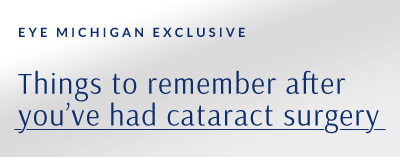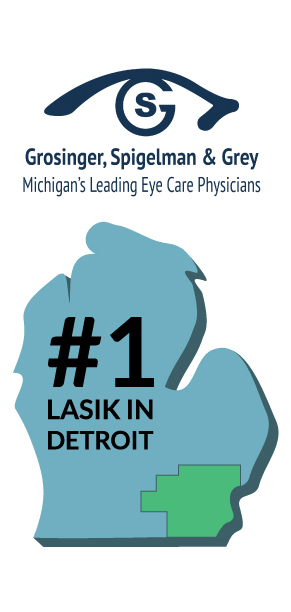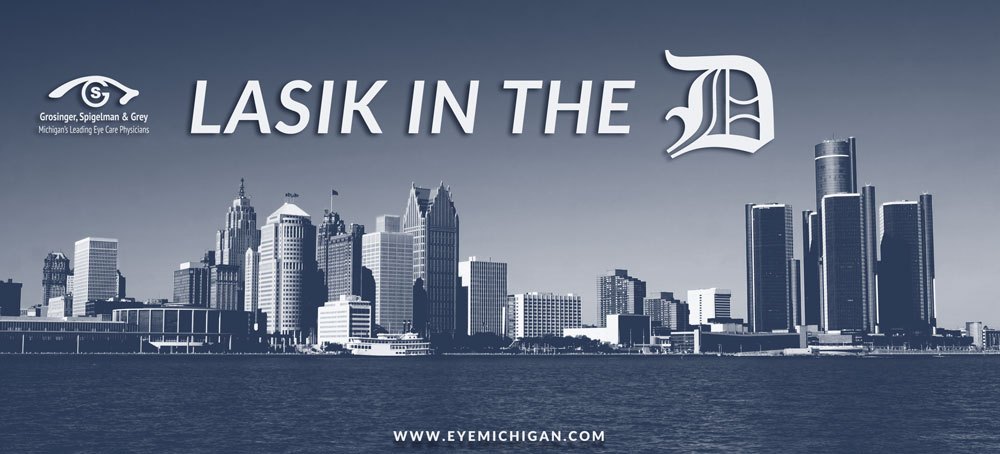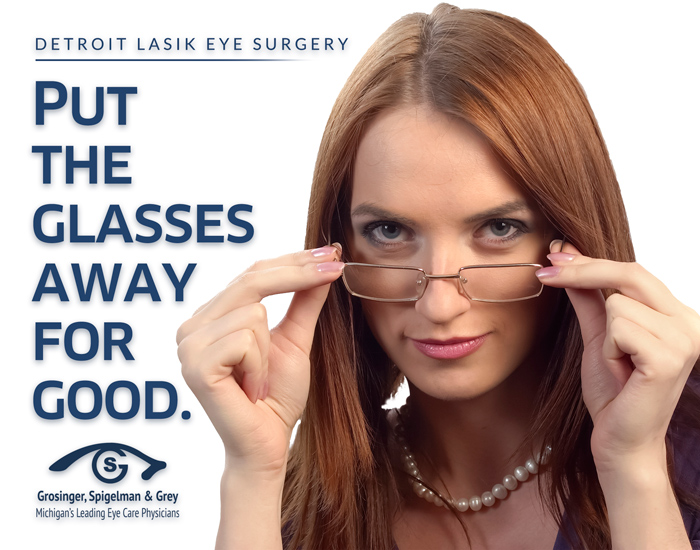https://youtu.be/LCzKT7DETQU
What Not to Do Following Cataract Surgery
 What Not to Do Following Cataract Surgery
What Not to Do Following Cataract Surgery
Once the surgeon is finished with your cataract surgery, you will spend time in your hospital room until the doctor has come by to make sure everything is ok. He will then schedule a number of follow up visits to check on the health of your eyes and the success of his work. During this post-operative period you will be required to administer anti-microbial eye drops intended to help speed the healing process. You must also apply corticosteroid drops to keep inflammation down, and cycloplergic drops which will help reduce your sensitivity to bright lights.
Problems to Look For
During the post cataract surgery recovery period you should look out for a number of symptoms that could indicate a problem. Among these are your eye becoming painful and red, pain that becomes steadily worse over time, and any sudden loss of vision. If you experience these symptoms or flashes of light or a severe headache, you need to contact your doctor immediately.
Things You Should Not Do After Your Cataract Surgery
There are several things you should not do following your surgery as they can cause permanent and irreversible damage to your eye. These include:
- Not rubbing or squeezing your eye
- Not allowing water to get into your eye while bathing
- Allow anything other than your eye drops to get into your eye
- Allow anyone or anything to hit you in the face
- Perform any type of vigorous exercise until approved by your doctor
- Drive until your doctor tells you that it is safe to do so
As long as you follow this advice as well as your doctor’s orders to the letter your eye should recovery completely. If your doctor performed the surgery using the phacoemulsification method the recovery period should be between 3 and 4 weeks. If he used a larger incision and closed it using stitches, the recovery period may be as long as 2 to 3 months. But no matter which method he uses the recovery should be full and your eyesight fully restored.
Eye Michigan (Doctors Grosinger, Spigelman & Grey) have been performing corrective optical surgeries for over 30 years, and have extensive experience in the field of eye medicine. Call them today for a free consultation or screening.
First and Best LASIK Procedures in Detroit, Michigan
 One of the first practices to perform LASIK eye surgery in Detroit was Doctors Grosinger, Spigelman and Grey at Eye Michigan. The doctors took part in the original FDA study which took place starting in October of 1991 and were the first in the entire southeastern region of Michigan to perform the procedure.
One of the first practices to perform LASIK eye surgery in Detroit was Doctors Grosinger, Spigelman and Grey at Eye Michigan. The doctors took part in the original FDA study which took place starting in October of 1991 and were the first in the entire southeastern region of Michigan to perform the procedure.
Since the initial study there have been millions of people who have undergone LASIK eye surgery and millions have benefited from LASIK surgery. LASIK or laser-assisted in situ keratomileusis is a procedure that reshapes the cornea to improve how light is refracted in the retina of your eye. The result of this procedure is that the light entering the eye is now being focused properly and your vision will be improved so that you will be able to see more clearly. The LASIK procedure has been around since the 1980s when it was done manually with a scalpel. Even with the manual procedure it was highly successful. The success rate for the current procedure is exceptionally high at 95%. The procedure has evolved into a two-step process. First a laser is used to access the cornea tissue. A flap is created on the surface of the cornea that allows an excimer or ultraviolet laser to remove tissue and reshape the cornea. The procedure takes about one hour and requires no hospitalization.
The LASIK procedure has been around for many years and continues to evolve. Millions have had the procedure done on them and have improved their eyesight as a result. Doctors Grosinger, Spigelman and Grey were the first practice to perform LASIK laser eye surgery in Detroit and they still perform some of the most advanced LASIK Procedures available today. You can hear just what their patients have to say here. So call today and we’ll get you started with a consultation!
LASIK Pioneers in Metro Detroit
 The City of Detroit has a long and colorful history since its founding over 300 years ago. The city started as a small fur trading post and has grown to be one of the largest cities in America. Detroit is currently the largest city in the State of Michigan. The automotive industry helped to shape this city and brought industry and commerce to this area but what about the LASIK industry?
The City of Detroit has a long and colorful history since its founding over 300 years ago. The city started as a small fur trading post and has grown to be one of the largest cities in America. Detroit is currently the largest city in the State of Michigan. The automotive industry helped to shape this city and brought industry and commerce to this area but what about the LASIK industry?
Laser eye surgery involves removing corneal tissue to correct nearsightedness, farsightedness and astigmatism. The cornea is the part of the eye that focuses light on the retina. It is similar to a camera lens that will create the image on film. If the shape of the cornea is not perfect then the image will be blurred and the person will require glasses or contacts to see clearly. Laser eye surgery can be done for people who are nearsighted, farsighted and even those who have astigmatism.
Laser assisted in situ keratomileusis or LASIK uses a laser to reshape the cornea. The main difference between PRK and LASIK is that in PRK the top layer of the cornea is scraped away to expose the stromal layer and in LASIK the stromal layer is cut and a flap is folded back. There is a 95% success rate with LASIK and there is no hospitalization required for this procedure. The procedure takes approximately one hour and patients report better vision immediately following the procedure. There have been complications from the surgery and these include haloing and difficulty seeing at night. The advances in this procedure though have made these problems occur much less than when it began.
In summary, the metro Detroit area has many options for laser eye surgery because of the infrastructure that was there during the automotive boom giving the residents of Detroit many options when choosing laser eye surgery.
Like Henry Ford of the Auto industry, doctors Grosinger, Spigelman & Grey of Eye Michigan are pioneers when it comes to LASIK Eye surgery in Metro Detroit and its surrounding areas. Do you think you could benefit from the most leading corrective eye surgery available today? Call (248) 221-1022 or (248)333-3539 today and we will set you up with a consultation at our Bloomfield Hills Office.
Common Misconceptions of LASIK Eye Surgery
 There many common misconceptions of LASIK eye surgery and unfortunately these prevent some people who could benefit from taking advantage of this great development in eye surgery.
There many common misconceptions of LASIK eye surgery and unfortunately these prevent some people who could benefit from taking advantage of this great development in eye surgery.
Misconception One – My eyesight is too bad for LASIK eye surgery
There are limits to any technology but when it comes to LASIK eye surgery if your are already wearing glasses or contacts to correct your vision then chances are that LASIK will be able to help you. LASIK technology continues to improve and with each advancement in technology the number of people who can benefit also grows.
Misconception Two – I can’t get LASIK because I have astigmatism
This is one of the biggest misconceptions regarding LASIK and is entirely false. LASIK surgery can help nearsightedness, farsightedness and people who have astigmatism.
Misconception Three – I’m too young or old for LASIK surgery
To determine whether or not you are a candidate for LASIK does not depend on your age. All that matters is that your eyes are stable and not changing. There is no upper or lower age limit for LASIK.
Misconception Four – I’ll have to wear glasses after LASIK anyways
A majority of people who have LASIK surgery do not need to wear any prescription glasses after the procedure.
Misconception Five – I can’t risk LASIK, my job depends on my eyesight
LASIK surgery has been approved for pilots, firefighters, and astronauts, all of which rely on their eyesight to perform their job. These professions have found that glasses can be broken and contacts lost so surgically corrected eyesight is a much safer alternative.
Misconception Six – I was told I am not a candidate for LASIK
Even if you were told many years ago you were not a candidate for LASIK it is very likely that you are now. The technology continues to improve and with the new advances we have today you most likely are a candidate with today’s technology.
So, no matter what you’ve thought or heard in the past it may be time to give LASIK surgery another look and see that the common misconceptions of LASIK eye surgery no longer apply to you.
The doctors at Grosinger, Spigelman & Grey are certified experts in the realm of LASIK eye surgery and have been so for over 30 years.
Serving the Metro Detroit area, Eye Michigan are the doctors to call when it’s time for your LASIK eye surgery.
Understanding Cataract Surgery
 Cataracts are defined as a clouding of the lens of the eye that can impair vision. Cataracts form over time and are generally painless, simply causing blurred or distorted vision. While the exact cause of cataracts is not known, they can appear with age, eye trauma, genetic disease, or a number of other factors. In most cases, cataracts appear in both eyes but it is not uncommon for one eye to develop a cataract faster than the other. Surgery is often recommended if cataracts impair the doctor’s ability to treat other eye ailments and conditions, or if they begin to cause difficulty with performing everyday tasks.
Cataracts are defined as a clouding of the lens of the eye that can impair vision. Cataracts form over time and are generally painless, simply causing blurred or distorted vision. While the exact cause of cataracts is not known, they can appear with age, eye trauma, genetic disease, or a number of other factors. In most cases, cataracts appear in both eyes but it is not uncommon for one eye to develop a cataract faster than the other. Surgery is often recommended if cataracts impair the doctor’s ability to treat other eye ailments and conditions, or if they begin to cause difficulty with performing everyday tasks.
How Cataract Surgery Works
Cataract surgery is an outpatient procedure and is performed by a specially trained surgeon called an ophthalmologist. The procedure involves making a small incision near the cornea. Once the incision is made, a microscopic ultrasonic probe is inserted and used to destroy the damaged cornea. The pieces of cornea are suctioned through the same incision point. Once the cornea is removed it is replaced with a synthetic lens. The most commonly used synthetic lens is the monofocal lens, which is the same strength throughout the entire lens. Patients with a monofocal lens will generally need light corrective lenses. Toric lenses are specially designed lenses that can be used to correct astigmatism, however patients with toric lenses will require reading glasses for any up close tasks. Once the artificial lens is inserted, the incision is closed.
Patients can expect to have blurred vision for a few days after surgery. This is normal as the eye is healing and adjusting to the new lens. The doctor may prescribe medicated eye drops or require the patient to wear an eye patch or protective shield during the healing process. Mild itching and discomfort are a normal part of the healing process during the first few days and will fade quickly. Patients will meet with their ophthalmologist several times throughout the healing process, once at two days, a week, and then a month following surgery. The healing process is generally complete within 8 weeks.
Grosinger, Spigelman & Grey have been in their respective fields for a combined 30 + years, and they are some of the most experienced eye doctors in the Metro Detroit area. Come in today for a consultation and find out why so many people trust Eye Michigan for their optical needs. LASIK, Cataracts, you name it – G, S & G will have you seeing clear in no time.
Seasonal Eye Care
 The changing of the seasons brings about many changes in everyday life, from clothing and food choices to how people take care of themselves. One thing that is commonly overlooked is how they care for their eyes throughout the seasons, particularly in the late fall and winter when temperatures drop. Eyes are particularly at risk for injury during the cold winter months. Recognizing the symptoms of eye injury and knowing what protective measures are available will increase a person’s ability to avoid eye injury.
The changing of the seasons brings about many changes in everyday life, from clothing and food choices to how people take care of themselves. One thing that is commonly overlooked is how they care for their eyes throughout the seasons, particularly in the late fall and winter when temperatures drop. Eyes are particularly at risk for injury during the cold winter months. Recognizing the symptoms of eye injury and knowing what protective measures are available will increase a person’s ability to avoid eye injury.
Signs and Symptoms of Cold Weather Eye Injuries
Two of the most commonly seen winter eye injuries are sun damage and dry eyes. Sun damage is caused by the sun’s UV rays reflecting off the snow or ice. It can cause damage to the corneal tissues resulting in blurred vision, extreme sensitivity to light, eye spasms, and red eyes. In some cases medicated eye drops may be required to prevent infection and soothe the eyes. Over exposure to UV light is also a leading factor in the formation of cataracts, which is a clouding of the cornea. Doctors strongly recommend dark glasses to protect the eyes from the sun while skiing, snow shoveling, hiking, or any other outdoor activities.
Dry eyes are more common in the winter when there is a decrease in humidity, with windows closed and heaters on. Dry eye may also occur when people attempt to force their eyes open during windy conditions or while participating in outdoor activities such as skiing, sledding, and snowmobiling. Symptoms of dry eyes include red or itchy eyes, a feeling that there is something in the eye, blurred vision, and potential damage to the cornea. This winter eye condition is easy to treat. Common treatments are using a humidifier indoors, making sure to blink often, using eye drops, and wearing dark glasses when participating in outdoor activities. It is important for people to take proper care of their eyes during the winter months to ensure overall eye health as well as gain the most enjoyment from the winter season.
If you think you may need proper eye care this time of year like medicated eye drops, be sure to give Eye Michigan a call and we’ll set up an appointment for you right away (248) 221-1022.
Happy Holidays From All of Us at Grosinger, Spigelman & Grey
Understanding LASIK Eye Surgery – Detroit LASIK Center Grosinger, Spigelman & Grey
 A large percentage of the American population uses various forms of corrective lenses to improve their vision. There are a number of different eye ailments that may cause a person to need corrective lenses, such as astigmatism, nearsighted, or farsightedness, or even partial cataracts. To correct their vision many people use contact lenses while others prefer the more traditional look of glasses. A growing number of people are searching for alternatives to the various types of corrective lenses. LASIK, or Laser-Assisted-In-Situ-Keratomileusis, is one of the most commonly performed corrective treatments available today.
A large percentage of the American population uses various forms of corrective lenses to improve their vision. There are a number of different eye ailments that may cause a person to need corrective lenses, such as astigmatism, nearsighted, or farsightedness, or even partial cataracts. To correct their vision many people use contact lenses while others prefer the more traditional look of glasses. A growing number of people are searching for alternatives to the various types of corrective lenses. LASIK, or Laser-Assisted-In-Situ-Keratomileusis, is one of the most commonly performed corrective treatments available today.
The LASIK Process
The first commercial use of LASIK eye surgery was implemented in 1991 in ten special vision clinics. Since its implementation LASIK has seen several advances in technology making it safer, faster, and more effective. The actual surgical process is relatively quick, with the procedure taking approximately 60-90 minutes from beginning to end. Before the surgery begins anesthetic eye drops are applied. Once the eye is numb, a special suction tool is used to stabilize the eye for surgery. Once the eye is stabilized, a small flap is made in the surface of the cornea and lifted to the side. A specially designed laser is then used to reshape the cornea and then the flap is set back in place. A bandage contact lens is applied and the procedure is finished.
It is important to follow all care instructions given by the ophthalmologist. Patients are given antibiotic eye drops as well as special drops to reduce inflammation. These drops are used for several weeks following the procedure. In addition to medicated eye drops, patients are given dark glasses, and at times protective goggles, to protect their eyes from exposure to bright lights and rubbing while sleeping. Most patients are able to resume their normal activities the day after their procedure. Effects of LASIK may be seen within minutes of the completion of the surgical procedure and further vision improvements will develop over the next several weeks or months.
Grosinger, Spigelman & Grey will have you seeing crystal clear in no time at all. With over 30 years of combined experience in the industry, you’ll be well on your way to no longer depending on your corrective lenses.
What to Expect With LASIK Surgery
 Laser Assisted In Situ Keratomileusis, or LASIK, is one of the most commonly performed ocular surgeries. Most people who elect to have the procedure, do so to eliminate the need for corrective lenses such as contacts or glasses. LASIK eye surgery is used to change the shape of the cornea so that it reflects light into the retina properly. Laser eye surgery is primarily used to treat myopia (nearsightedness), hyperopia (farsightedness), and astigmatism (irregularly shaped cornea). As with any surgery it is important to have a good understanding of pre-and post-operative care as well as the procedure itself.
Laser Assisted In Situ Keratomileusis, or LASIK, is one of the most commonly performed ocular surgeries. Most people who elect to have the procedure, do so to eliminate the need for corrective lenses such as contacts or glasses. LASIK eye surgery is used to change the shape of the cornea so that it reflects light into the retina properly. Laser eye surgery is primarily used to treat myopia (nearsightedness), hyperopia (farsightedness), and astigmatism (irregularly shaped cornea). As with any surgery it is important to have a good understanding of pre-and post-operative care as well as the procedure itself.
Before, During, and After LASIK Surgery
Before laser eye surgery is performed, patients will undergo a thorough examination with an ophthalmologist to determine if surgery is an option. If it is determined that surgery can be performed, a pre-operative care routine is established in the weeks before surgery. Patients who wear contacts, which can change the shape of the cornea, will be instructed to stop wearing them and begin wearing glasses full time for several weeks before the surgery date. In addition to wearing glasses, patients must clean their eyelashes regularly and refrain from using eye makeup a few days before and after surgery. Patients will need to have a ride home as their eyes will be extremely sensitive.
The LASIK procedure is short, with average surgeries lasting between 60-90 minutes from start to completion. Before the surgery begins the patient will be given a mild sedative and anaesthetic eye drops will be applied. The eye is then stabilized and a special tool called a microkeratome is used to cut a small flap in the cornea, which is pushed to the side. A specially designed laser is then used to reshape the cornea and the flap is set back in place.
After surgery, a patient’s eyes will be extremely sensitive. The doctor will prescribe medicated eye drops as well as synthetic tears to keep the eyes moist. In addition to eye drops, patients will be given dark glasses or goggles to protect the eyes from bright lights and rubbing. It is important to follow all instructions given by the ophthalmologist to ensure proper healing. A follow up visit will be scheduled to ensure that the eyes are healing properly.
Grosinger, Spigelman & Grey have been mastering corrective laser eye procedures since the technology’s discovery and beta phase many, many years ago. Now harnessing some of the very best options available (like LenSx and Allegretto), Eye Michigan has the right answer for you so contact us today!
